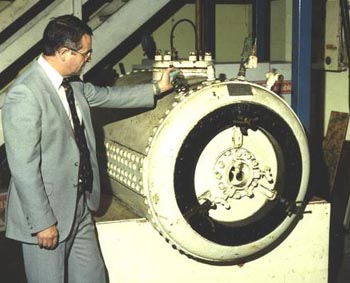
 |
MIXED GASES & GOATS - NICK BAKER
From very early on it was recognised that the way forward for deep diving was through the use of mixed gas, particularly mixtures of helium and oxygen. Unfortunately for the British, supplies of helium were limited. The only source was natural gas wells in the United States and the Americans were reluctant to export. Therefore the British were forced to push air diving to its absolute limit and by the use of the Davis Submersible Decompression Chamber or D.S.D.C., manufactured by Siebe Gorman & Company, they pushed air diving to 350 feet, its absolute limit.
This tank was used during the 1920s in experiments at Siebe Gorman & Company into mixed gas: helium and oxygen. Although helium was unobtainable in the UK during that period Sir Robert Davis managed to secure a supply which was left over from the 1st World War. He used this helium in conjunction with oxygen to carry out a number of experiments on goats and indeed this is known as the goat chamber.

The goat, probably feeling a little better now that its dive was coming to an end, was looking around for something to eat and it discovered two wires poking through the top of the chamber here. These would ordinarily have been attached to a light bulb. There was no bulb fixed at the time and the wires had simply been taped together: they were also live. This was unknown to both the researchers and the goat. The goat nuzzled at the wires, and began to chew them, and made an electrical contact.
Captain Damant was the first to notice that something was wrong. He observed a flash through the observation port in the chamber at its far end. He, probably the most practical person in the room, suggested that everyone should take cover. Two eminent physiologists, the chairman of Siebe Gorman and Captain Damant cowered under the table. Captain Damant later confided in his journal that he fully expected the chamber to explode and shrapnelise.
However, fortunately for everyone except the goat perhaps, the rubber seal around the door of the chamber burnt away and a sheet of flame and the smell of roast goat shot out into the room. Sometime later, when the chamber had cooled enough for the door to be fully opened, all that could be seen of the goat was a carbonised shell with its teeth still firmly clamped onto the electric wires. And I think as divers we have to remember the debt that we owe to those goats that have helped in physiological research into decompression.
 |